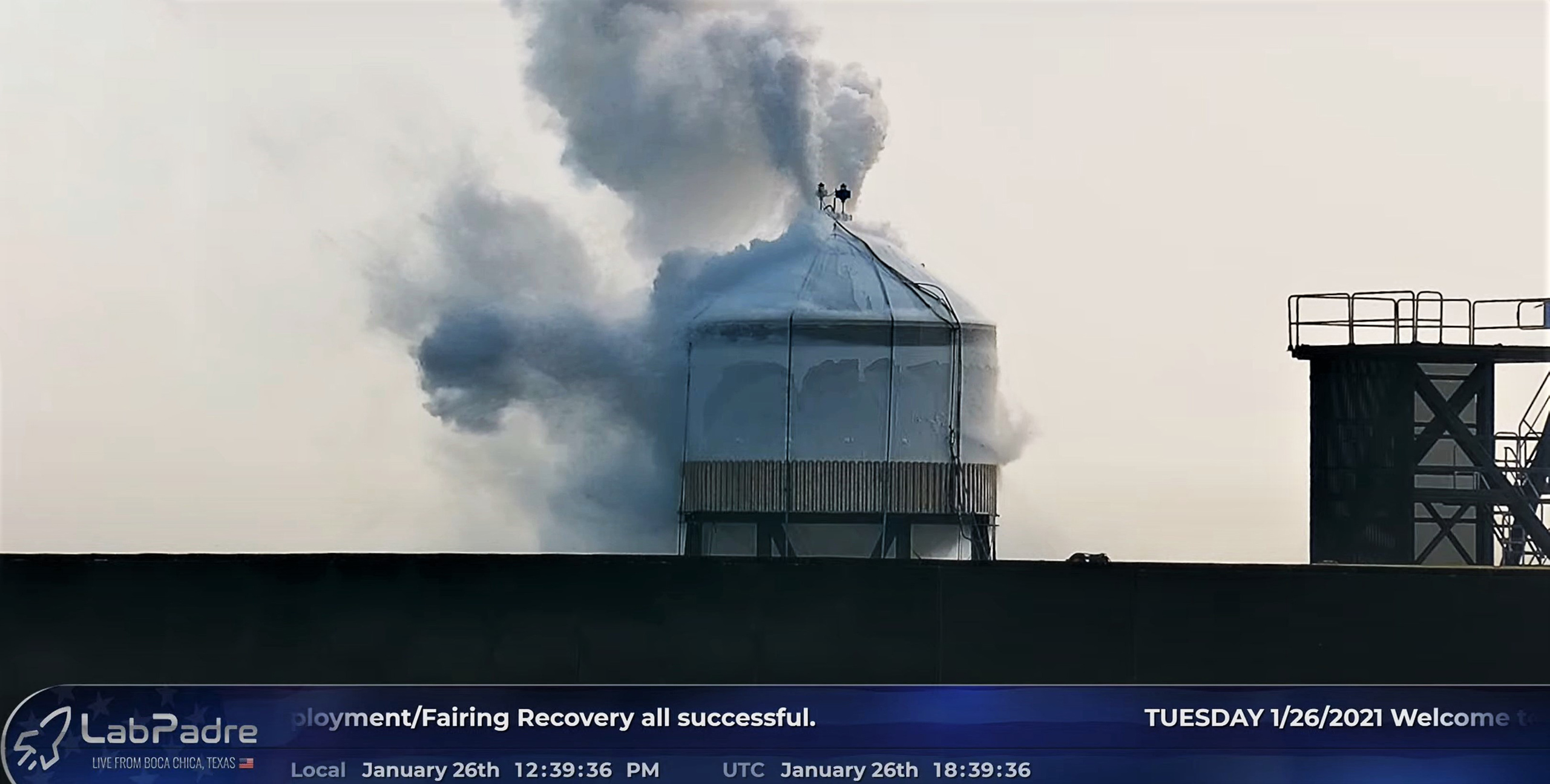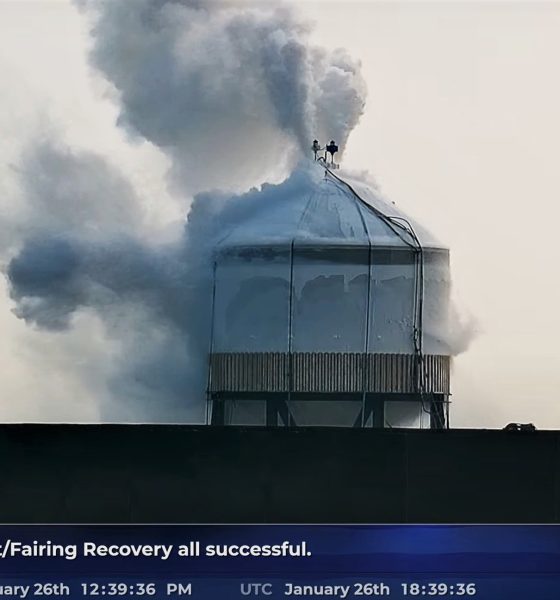

News
SpaceX’s thin-skinned Starship ‘test tank’ passes first trial
CEO Elon Musk says that a new thin-skinned Starship ‘test tank’ just passed its first trial, taking advantage of delays to Starship SN9’s planned high-altitude launch debut.
Delayed by a lack of FAA approval for unknown reasons, Starship SN9’s 12.5-kilometer (7.8 mi) launch debut (virtually identical to SN8’s 12.5 km launch last month) is in limbo pending an “FAA review” according to Musk. SpaceX thus found itself with at least 24 hours of guaranteed inactivity for Starship SN9, time the company rapidly chose to fill with crane transportation and, more importantly, the first Starship ‘test tank’ stress test in months.
Known as Starship SN7.2, SpaceX’s latest ‘test tank’ is the third to carry the SN7 moniker and appears to have been built primarily to test refinements to the rocket’s structural design. Following test tanks SN7.0 and SN7.1, both used to qualify the use of a new steel alloy on an otherwise unchanged design, SN7.2 – likely built out of the same alloy – is instead focused on determining if SpaceX can begin trimming the margins of an increasingly mature technology.


Curiously, SN7.2 is a sort of fusion of its predecessors: combining the stout stature of SN7.0 with SN7.1’s use of an aft thrust dome, but without SN7.1’s Starship-style skirt (the three rings at its bottom). Welded directly to its black test stand, it’s unclear why SpaceX chose to give SN7.2 a thrust dome, given that the thrust of Raptor engines can only be simulated with hydraulic rams if the tank is installed on one of two Starship launch mounts.
Regardless, whether SpaceX actually tests that aspect of SN7.2, the tank’s most important task is determining if future Starships (and perhaps Super Heavy boosters) can be built out of thinner, lighter steel rings. Its domes appear to be identical to past ships but writing on the exterior of the tank strongly implied that its three rings were built out of 3mm steel rather than the 4mm sheets that have made up every Starship built in the last 12 months.
SpaceX began loading the thin-skinned tank with liquid nitrogen (used to simulate cryogenic propellant without the risk of an explosion) around 9am CST and spent around three hours performing an “initial pressure test.” It’s unclear what that test entailed but it most likely involved raising the tank’s internal pressure to levels achieved by SN7.0 and SN7.1 Musk has previously said that that 6 bar was the bare minimum necessary for orbital flight, translating to 7.5-8.5 bar to achieve an industry-standard safety margin of 25-40%.
That SN7.2 survived that initial pressure test bodes well for the significant mass reductions SpaceX will need to optimize Starships for efficient orbital flight, potentially shaving 5-10 metric tons off the dry mass of future ships. For orbital rocket stages, every single kilogram of mass reduction translates to an extra kilogram of cargo capacity, whereas boost stages (i.e. Super Heavy) offer far more lenient ratios on the order to 10:1, meaning that adding 5-10 kilograms of rocket hardware reduces maximum payload capacity by just ~1 kg.
Depending on when SpaceX is allowed to launch Starship SN9, the company’s next test could involve pressurizing SN7.2 until it bursts, determining if the tank’s thinner skin substantially impacts its performance as a pressure vessel.

Elon Musk
SpaceX issues statement on Starship V3 Booster 18 anomaly
The incident unfolded during gas-system pressure testing at the company’s Massey facility in Starbase, Texas.

SpaceX has issued an initial statement about Starship Booster 18’s anomaly early Friday. The incident unfolded during gas-system pressure testing at the company’s Massey facility in Starbase, Texas.
SpaceX’s initial comment
As per SpaceX in a post on its official account on social media platform X, Booster 18 was undergoing gas system pressure tests when the anomaly happened. Despite the nature of the incident, the company emphasized that no propellant was loaded, no engines were installed, and personnel were kept at a safe distance from the booster, resulting in zero injuries.
“Booster 18 suffered an anomaly during gas system pressure testing that we were conducting in advance of structural proof testing. No propellant was on the vehicle, and engines were not yet installed. The teams need time to investigate before we are confident of the cause. No one was injured as we maintain a safe distance for personnel during this type of testing. The site remains clear and we are working plans to safely reenter the site,” SpaceX wrote in its post on X.
Incident and aftermath
Livestream footage from LabPadre showed Booster 18’s lower half crumpling around the liquid oxygen tank area at approximately 4:04 a.m. CT. Subsequent images posted by on-site observers revealed extensive deformation across the booster’s lower structure. Needless to say, spaceflight observers have noted that Booster 18 would likely be a complete loss due to its anomaly.
Booster 18 had rolled out only a day earlier and was one of the first vehicles in the Starship V3 program. The V3 series incorporates structural reinforcements and reliability upgrades intended to prepare Starship for rapid-reuse testing and eventual tower-catch operations. Elon Musk has been optimistic about Starship V3, previously noting on X that the spacecraft might be able to complete initial missions to Mars.
Investor's Corner
Tesla analyst maintains $500 PT, says FSD drives better than humans now
The team also met with Tesla leaders for more than an hour to discuss autonomy, chip development, and upcoming deployment plans.

Tesla (NASDAQ:TSLA) received fresh support from Piper Sandler this week after analysts toured the Fremont Factory and tested the company’s latest Full Self-Driving software. The firm reaffirmed its $500 price target, stating that FSD V14 delivered a notably smooth robotaxi demonstration and may already perform at levels comparable to, if not better than, average human drivers.
The team also met with Tesla leaders for more than an hour to discuss autonomy, chip development, and upcoming deployment plans.
Analysts highlight autonomy progress
During more than 75 minutes of focused discussions, analysts reportedly focused on FSD v14’s updates. Piper Sandler’s team pointed to meaningful strides in perception, object handling, and overall ride smoothness during the robotaxi demo.
The visit also included discussions on updates to Tesla’s in-house chip initiatives, its Optimus program, and the growth of the company’s battery storage business. Analysts noted that Tesla continues refining cost structures and capital expenditure expectations, which are key elements in future margin recovery, as noted in a Yahoo Finance report.
Analyst Alexander Potter noted that “we think FSD is a truly impressive product that is (probably) already better at driving than the average American.” This conclusion was strengthened by what he described as a “flawless robotaxi ride to the hotel.”
Street targets diverge on TSLA
While Piper Sandler stands by its $500 target, it is not the highest estimate on the Street. Wedbush, for one, has a $600 per share price target for TSLA stock.
Other institutions have also weighed in on TSLA stock as of late. HSBC reiterated a Reduce rating with a $131 target, citing a gap between earnings fundamentals and the company’s market value. By contrast, TD Cowen maintained a Buy rating and a $509 target, pointing to strong autonomous driving demonstrations in Austin and the pace of software-driven improvements.
Stifel analysts also lifted their price target for Tesla to $508 per share over the company’s ongoing robotaxi and FSD programs.
Elon Musk
SpaceX Starship Version 3 booster crumples in early testing
Photos of the incident’s aftermath suggest that Booster 18 will likely be retired.

SpaceX’s new Starship first-stage booster, Booster 18, suffered major damage early Friday during its first round of testing in Starbase, Texas, just one day after rolling out of the factory.
Based on videos of the incident, the lower section of the rocket booster appeared to crumple during a pressurization test. Photos of the incident’s aftermath suggest that Booster 18 will likely be retired.
Booster test failure
SpaceX began structural and propellant-system verification tests on Booster 18 Thursday night at the Massey’s Test Site, only a few miles from Starbase’s production facilities, as noted in an Ars Technica report. At 4:04 a.m. CT on Friday, a livestream from LabPadre Space captured the booster’s lower half experiencing a sudden destructive event around its liquid oxygen tank section. Post-incident images, shared on X by @StarshipGazer, showed notable deformation in the booster’s lower structure.
Neither SpaceX nor Elon Musk had commented as of Friday morning, but the vehicle’s condition suggests it is likely a complete loss. This is quite unfortunate, as Booster 18 is already part of the Starship V3 program, which includes design fixes and upgrades intended to improve reliability. While SpaceX maintains a rather rapid Starship production line in Starbase, Booster 18 was generally expected to validate the improvements implemented in the V3 program.
Tight deadlines
SpaceX needs Starship boosters and upper stages to begin demonstrating rapid reuse, tower catches, and early operational Starlink missions over the next two years. More critically, NASA’s Artemis program depends on an on-orbit refueling test in the second half of 2026, a requirement for the vehicle’s expected crewed lunar landing around 2028.
While SpaceX is known for diagnosing failures quickly and returning to testing at unmatched speed, losing the newest-generation booster at the very start of its campaign highlights the immense challenge involved in scaling Starship into a reliable, high-cadence launch system. SpaceX, however, is known for getting things done quickly, so it would not be a surprise if the company manages to figure out what happened to Booster 18 in the near future.








